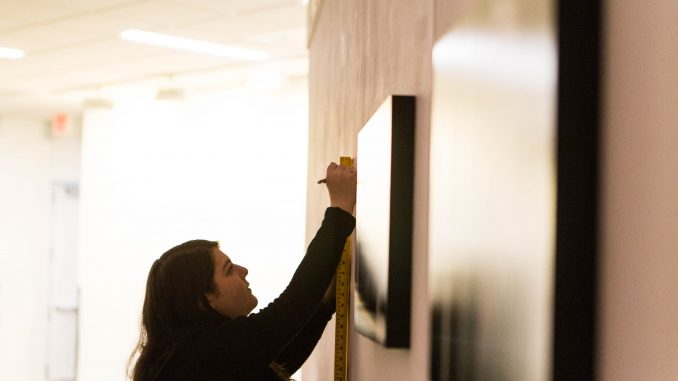
In January 2015, Taylour Green’s parents moved from her childhood home in Coplay, Pennsylvania, to North Carolina while she was attending Temple. More than two years later, she wanted to create a photo exhibit to process her feelings about the transition.
Grabbing a stack of paper from her printer, Green filled five pages with her thoughts and poems about the move to help her organize her senior thesis exhibit, “Elsewhere.” Today, snippets of those notes adorn her photo collages and an accompanying exhibition book.
“My parents are 500 miles away, so I have to do these things that I’m not used to,” said Green, a senior photography major. “Of course, yeah, you have to start scheduling your own doctor’s appointments by yourself and showing up to them. But your parents aren’t there to hold your hand when the doctor tells you the results.”
Green will join six other graduating photography majors to present their BFA thesis exhibitions on Wednesday through Dec. 9 in the lower atrium of the Tyler School of Art. The opening reception will be held on Friday from 6 to 9 p.m.
One of the other featured artists, Lauren Obadiah, became interested in photography through her high school darkroom classes. She started a music blog, Take A Shot Media, where she posted band interviews and concert photography of artists like Taking Back Sunday, Third Eye Blind and Joan Jett.
Once Obadiah came to Tyler, she began exploring non-objective photography, a type of art that often emphasizes simple, geometric forms. Because she said contemporary photography typically focuses on portraiture, Obadiah has sought inspiration from abstract expressionist painters like Mark Rothko and Jackson Pollock — mid-20th century artists known for their gestural brushwork and abstract imagery.
“Abstract expressionists were working during the time of World War II,” Obadiah said. “But instead of making art that was obviously about that, they were more interested in the psychology behind it and emotion.”
Her exhibit, “Spatial Reconstructions,” displays abstracted, black-and-white photography of buildings and streetscapes in Center City Philadelphia and New York. While some photos depict the exteriors of buildings that are distorted through the reflection of a window, others highlight close-up textures of objects like door handles and metallic window frames.
A common initial impression of Obadiah’s work, she said, is a sense of confusion. She often has to explain her interest in geometry and abstraction to help viewers better understand her intentions.
But despite the lack of personal information in her art, Obadiah said she feels it can still be relatable.
“For me, taking pictures like that is an outlet and it’s a way to see the world in my own kind of way,” Obadiah said. “And I hope other people can look at it and see what they want to see and feel what they want to feel.”
“Personally, they give me a sense of stability and calmness,” she added. “They make me feel grounded.”
In Green’s exhibit, she brings her personal experiences to the forefront.
During her parents’ move, Green found dozens of old childhood photographs — which depict activities like getting on the school bus and playing in the snow — and collected them in a Vans shoe box. She later scanned more than 100 of them onto her computer.
Green then combined her recent photography with these old photos to create a series of photo collages, each one relating to an aspect of home and her memories of childhood. Through the project, she said she realized “home” is not a physical place, but a state of belonging.
“I think a lot of college students can relate to that idea of home being more of a concept and not a place,” Green said. “We’re kind of searching for something more, and I think what we’re searching for is stability.”
In one collage, Green said she juxtaposed a photo of her legs as a baby with a recent photo of her elbow to show the transformation of “then versus now.” In another, she used photos of a red car, notebook and the ribcage of an animal skeleton to illustrate the difficulty of transitioning into adulthood.
“The red image is supposed to be the immediate shock of realizing, ‘This is it, and I’ve been dropped into this new world by myself,’” Green said.
Although her photos are specific to her own experience, Green said several people have connected with the photos she has posted on Instagram.
“I had a couple people comment on it saying that it was relatable, and that made me feel really good because I want it to be,” Green said. “I want people to be able to relate to it and realize like, ‘You’re not alone when it comes to just growing up and being pushed into this new environment of being independent.’”


Be the first to comment